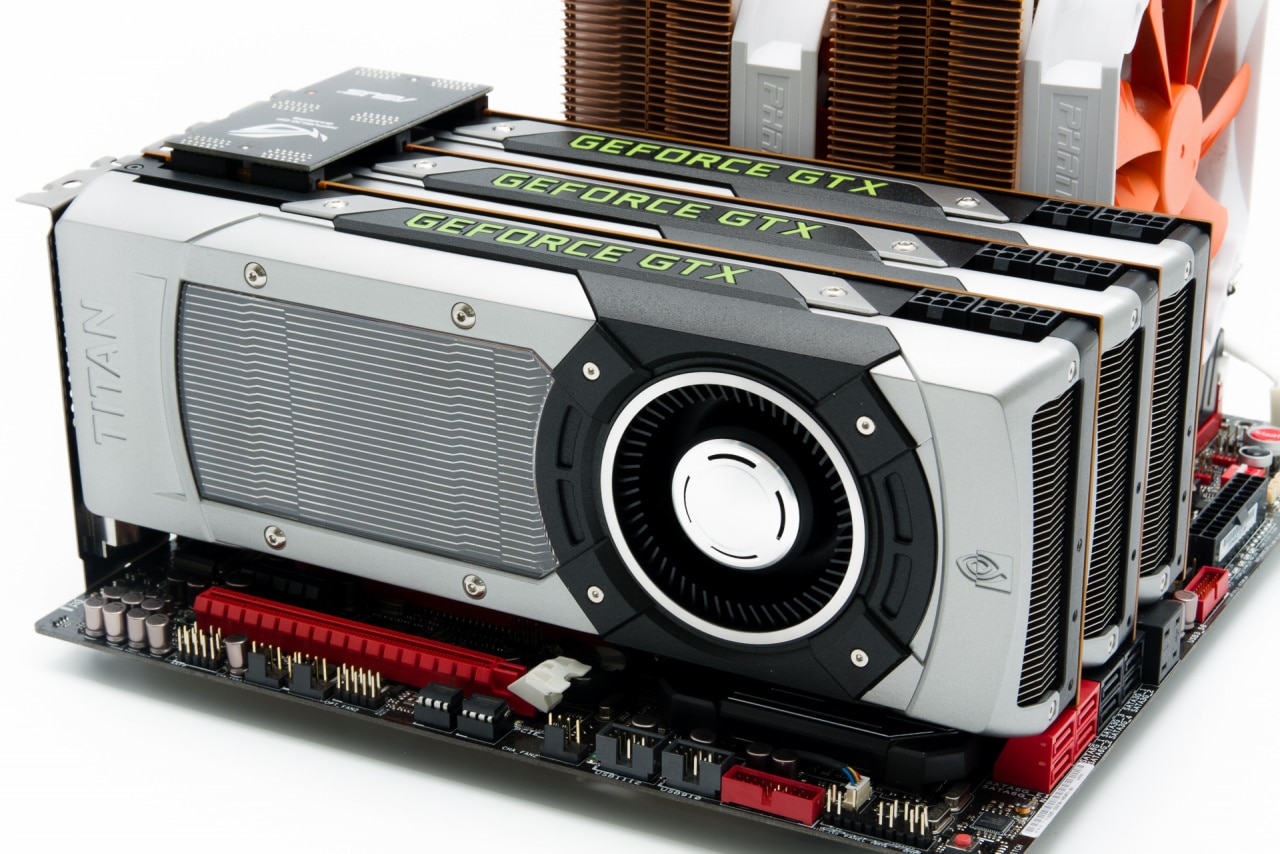Now its time. Just over a month ago, SweClockers reported that Nvidia has a new graphics card on the input in the absolute top tier, and quite rightly – Geforce GTX Titan is here. On the menu is the massive graphics processor GK110 and a graphics card beyond the ordinary.
Specification: Geforce GTX Titan
Geforce GTX Titan | Geforce GTX 690 | Geforce GTX 680 | |
|---|---|---|---|
Technical | 28 nm | 28 nm | 28 nm |
Circuit | GK110 | 2 x GK104 | GK104 |
Transistors | 7.1 billion | 2 x 3.5 billion | 3.5 billion |
Architecture | Kepler | Kepler | Kepler |
CUDA cores | 2 688 st. | 2 x 1 536 st. | 1 536 st. |
Clock frequency | 837 MHz | 915 MHz | 1 006 MHz |
GPU Boost | 876 MHz | 1 019 MHz | 1 059 MHz |
Computational power | 4 500 GFLOPS | 5 622 GFLOPS | 3 090 GFLOPS |
Computational power | 1 300 GFLOPS (1/3)* | 234 GFLOPS (1/24) | 128,7 GFLOPS (1/24) |
Memory bus | 384-bit | 2 x 256-bit | 256-bit |
Memory amount | 6 GB GDDR5 | 2 x 2 GB GDDR5 | 2 GB GDDR5 |
Memory frequency | 6 008 MHz | 6 008 MHz | 6 008 MHz |
Memory bandwidth | 288 GB/s | 2 x 192 GB/s | 192 GB/s |
Power supply | 6+8-pin | 8+8-pin | 6+6-pin |
Connection | PCI Express 3.0 | PCI Express 3.0 | PCI Express 3.0 |
Outputs | 2 st. DVI | 3 st. DVI | 2 st. DVI |
TDP | 250 W | 300 W | 195 W |
Rec. Award | 9,099 kr | 9,099 kr | 4,600 kr |
* Geforce GTX Titan decreases in clock frequency (from 837 MHz to 725 MHz) when dual precision support is enabled in the control panel.
The background to the Geforce GTX Titan is by now well known. The GK110 graphics processor was released in late 2012 and was used for Nvidia’s Tesla series computing cards, including in the world’s fastest supercomputer – Cray Titan at the Oak Ridge National Laboratory in the United States. Now the graphics processor will also be used in a graphics card for consumers.
Like other graphics processors with the Kepler architecture, the new graphics processor is based on 28 nanometer manufacturing technology. The Nvidia GK110 includes 15 SMX clusters for a total of 2,880 CUDA cores and 240 texture units – an increase of 87.5 percent from the GK104 in the Geforce GTX 680.
In addition, there are six memory controllers, each 64-bit, for a total of 384-bit and 48 raster units. The entire circuit contains a total of 7.1 billion transistors, making the GK110 the largest graphics processor and probably also the largest circuit in the consumer class of all time.
Although the Geforce GTX Titan contains a slightly scaled-down GK110, the specifications are still somewhat in the way of horses. Due to manufacturing technical reasons, Nvidia chooses to shut down an SMX cluster, resulting in 2,688 CUDA cores and 224 texture units. The clock frequency amounts to 837 MHz with “guaranteed” possibility to 876 MHz at GPU Boost.
However, the memory bus is untouched and remains at 384-bit width. This includes a full 6 GB of GDDR5 memory at 6,008 MHz, which gives 50 percent higher bandwidth than the former flagship Geforce GTX 680 – 288 gigabytes per second.
Despite the really large specifications, Nvidia states a fairly modest power consumption. Thermal Design Power (TDP) amounts to 250 watts, which can be compared to 195 watts in the Geforce GTX 680 or roughly equivalent to the Radeon HD 7970 Gigahertz Edition.
Geforce GTX Titan
To justify the resurrection, the graphics card itself is something out of the ordinary. The design is very reminiscent of the Geforce GTX 690, with lavish coolers and metal shells. As extra cream on the mash, the construction is adorned with an LED-lit logo (“Geforce GTX”) which can also flash or pulsate.
The shell consists of aluminum and has a window of acrylic plastic, which makes it possible to see the aluminum flanges. Instead of dissipating heat with heat conduction pipes, the cooling fins have contact with a steam chamber, which in practice can be seen as a large flattened heat conduction pipe. The 80 millimeter fan is in turn suspended in a magnesium frame and at the back of the card is the logo that reveals the name of the graphics card.
Despite the higher TDP value, Geforce GTX Titan offers acoustic and thermal properties that trump the previous flagship, Geforce GTX 680. According to Nvidia, the cooling is so good that the graphics card is also suitable for compact computer systems, such as the form factor Mini ITX.















